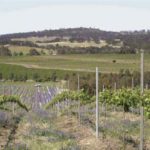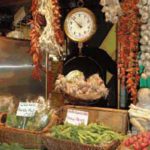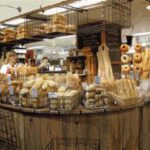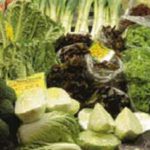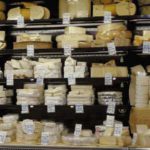Eating to live or living to eat? One could be forgiven for believing the Australians spend their lives concentrating on the latter, such is the wealth of their fresh produce, culinary communicators, chefs and restaurants.
ANGELA LLOYD
An event such as Tasting Australia sits naturally with such a culture. This bi-annual celebration of food and wine was launched in 1997, the recent 2007 event marking its 10th anniversary. As the official programme noted, it’s “Ten Years… and Growing”. The festival was the brainchild of Ian Parmenter, an expat British journalist passionate about food who approached the South Australian government. Adelaide, the capital of South Australia, was a natural choice of venue as it enjoys great hotels, food, chefs and restaurants as well as the proximity of several renowned wine regions.
This city on the Torrens River is home to around a million people, and lying in the heart of its CBD is the Adelaide Central Market. If there’s any environment that encapsulates the Australians’ fascination with food, it’s these markets found in the country’s major centres. Adelaide Central Market, housing more than 250 shops, claims the title of largest undercover market in the southern hemisphere. It is not only the scope of the produce that is eye-catching – the freshest fruit, vegetables, fish, meat, poultry and flowers – but the stalls offering these beautifully displayed goods, most of which are grown within an hour’s drive.
Other stalls loaded with breads, cheese of all sorts (tastings available too), coffees, teas and speciality food from all parts of the globe also tempt the eye, taste buds and pocket. The city’s wine heritage remains evident in the vines decorating the suburban shop fronts.
Adelaide is also home to the International Wine Centre, where interpretive displays take visitors through the winemaking process, including the opportunity to create your own wine with a show rating at the end. Today’s well-known wine regions fan out north to south around Adelaide. Except for Coonawarra, the furthest south, all are within a 90- minute drive of the city. Coonawarra (an hour by plane to Mount Gambier with a 30-minute drive back to the main town of Penola) is famed for its Terra Rossa (red earth) soil and its striking red wines, particularly cabernet and shiraz. Chardonnay and riesling are also worthy but overshadowed.
Local produce complements the wines at the many excellent winery restaurants found countrywide; they do much to attract visitors to the winelands. Coonawarra’s Upstairs at Hollicks sets the impressive tone. The Clare Valley, as gently undulating as Coonawarra is unrelentingly flat, is where riesling rules (the old, disused railway track between Auburn and Clare is now a riesling trail), though red is the majority grape colour. Screwcaps have dominated here since the riesling producers as a group started using them in 2000.
They keep the wine fresh and allow it to mature with toasty/limey complexity, as a Jim Barry 1999 and Mitchell 1992 illustrated. South Africans shouldn’t imagine screwcapped wines are for immediate drinking only nor exclusive to white wines; I came across many screwcapped reds, some of top quality, although many winemakers remain cautious about screwcapping reds. The aptly named Mount Lofty, rising 710 metres above Adelaide, signals the start of the cool-climate Adelaide Hills region, with its myriad winding roads and lush vegetation.
Apples, cherries, pears and vegetables share space with sauvignon blanc, chardonnay, pinot noir and shiraz (it compares with Elgin). Shiraz proved a delightful surprise, achieving great elegance and freshness without its general 14 percent alcohol being apparent. Shiraz grown in South Africa’s cooler areas – Elgin or Elim – doesn’t achieve the same finesse at similar alcohol levels, yet. Even in the Barossa, a warm region associated with big bruiser shiraz, there are producers cutting back on over-ripeness, over-extraction and over-oaking, a trend South African producers can beneficially follow.
Back at the food show 30 000 Australians experienced gastronomic delights at Feast of the Senses, “the best in Australian gourmet food, fine wine, premium beer, coffee and beverages” on the banks of the Torrens. They debated children’s eating habits at the Food Summit; cooked and ate with their offspring and celebrity chef presenters such as Antonio Carluccio, Madhur Jaffrey and Richard Fox. You see, Tasting Australia is as much for the public as the international media. The James Squire Food, Beer & Wine Writers’ Festival is a free event open to both and the topics discussed were as diverse as the panel members. Here are some highlights.
THE TERROIR-TORIALS
Rick Stein, Maggie Beer and Margaret Brooker contemplated the challenge of keeping food local and seasonal. Barossa resident Maggie reasoned she is able to use local and seasonal produce thanks to the Silesian settlers whose heritage is reflected in today’s farmers’ markets. But Rick Stein warned local produce will be expensive, saying, “Mass-produced supermarket food is here to stay.” Maggie’s retort, “Mass-produced food doesn’t have to be bad; hothousegrown New Zealand tomatoes are fine,” saw Rick claim variety has more impact on tomato flavour than whether they’re hydroponic or soil grown. Controversially, he declared, “Terroir is emotional rather than actual,” but recommended, “When in Barossa, eat Barossa.” Margaret’s pragmatic view that we’d never eat bananas or spices if they weren’t imported reiterates how much of a challenge buying and eating local and seasonal really is.
HEY GOOD LOOKING
Editors Andy Harris and Peter Hathaway, publisher Mary Small and chef-patron Shannon Bennett debated whether contemporary eating is a case of style over substance. While maintaining that food quality comes before service and design, Shannon acknowledged restaurants compete with many attractions. “Essentially it’s all a question of how to make the experience different from cooking at home,” he summarised. This includes commissioning his own idiosyncratic plates – one has a light underneath to illuminate the food.
For magazine editor Peter, photographs of wine and food are about selling a lifestyle. Static bottle and plate shots are passé. On cookbook covers too, agrees Mary. Fabric rather than food is the trend today; when you have three seconds to get people to pick up a book, design is important. Inside must be easy to use and uncluttered, so the reader can turn away and return to the right place. Andy adds that recipe photographs should create atmosphere but make the dish look easy. “If something tastes good, it shouldn’t be difficult to photograph.” In summary, both style and substance are necessary.
WINE – EVERYDAY TIPPLE FOR THE MASSES OR COGNOSCENTI ELIXIR?
Dining out and drinking wine has become an intrinsic part of Australian culture over the past 20 years. Australian wine writers Greg Duncan Powell, Ralph Kyte Powell and winemaker-turned-chef Kate Lamont discussed where it’s going. The quality of wine and the way it has been sold (49 percent bag-inthe- box) converted this non-table wine-drinking nation. Wine has also been demystified and democratised by good wine writers (screwcaps too); even older wines are not treated with too much reverence. The way forward is wine, food and conviviality as a team – Australia is on this road. There are lessons here too for South Africa, in keeping it straight and simple.
UP CLOSE AND PERSONAL
I had the opportunity of chatting to food gurus and writers Stephanie Alexander and Maggie Beer, and to Lebanese restaurateur Greg Malouf.
How would you describe your style of food and how does it fit into modern living?
Maggie: I’m totally produce-driven, focusing on what grows in the orchard or vegetable garden; I adapt according to what’s available. My dishes are simple and the excitement lies in the new season, not in the changing of style. Stephanie: I cook a broad range of food for myself and family. My cookbooks are intended for the home cook, whether for the young adolescent, ignorant man or sophisticate. My aim is to make recipes accessible and reduce the cook’s anxiety.
Greg: I follow my mother’s style, which is the norm throughout the Middle East. The food that is served reflects family values. The attitude of “never tried, so don’t like” isn’t experienced here, so an unusual mix such as tabbouleh with walnuts is appreciated by a wide group of people. It’s also simple to buy the right ingredients, though certain Lebanese ones are difficult to find in Adelaide because few Lebanese live here. My recipes vary from simple to complex.
How important is organic production?
Maggie: Organics are important but food isn’t better just because it is organic. And it makes no commercial sense to have organic produce if it has been picked three weeks ago and flown halfway around the world. Stephanie: I agree. I believe the best food is fresh food, preferably from one’s own garden. I dispute organic tastes better. Greg: It’s a requirement that’s growing. I prefer meat, poultry, seafood and pulses and grains that are organic. I buy vegetables with my eyes, so I can gauge how they’ve been grown. Australia has an incredible reputation for its food, both as fresh produce and in restaurants.
What’s the reason for this success?
Maggie: Immigration has so much to do with its success. Stephanie: There’s been a continuum since World War II, starting with Jewish refugees who brought real coffee and poppy seeds. Greeks and Southern Italians wanted imported olive trees and grew olives and made oil. The latest immigration has come from South East Asia and they’ve brought spices. But food is important across the country, not just the main centres, so you’ll find coriander in Wagga as well as in Adelaide. Greg: It’s all about exploring, letting the palate loose with the food cultures in the country. Here we are exposed to so many nationalities and if you have neighbours who are Greek or Italian, sooner or later you’ll eat tzatziki or spanakopita.
Bookshop shelves today are crowded with recipe books. What are the essentials for success?
Maggie: The recipes need to be uncomplicated – food should entice but not frighten. Stephanie: You have to have a profile and be well known, then people will trust your recipes. I’m happy to say my Cook’s Companion is in every restaurant. Greg: Testing and re-testing the recipes can take four to six weeks. The look of the book is the job of the publishers. The Middle East is all about colours, it’s easy to make the books evocative.
RECOMMENDED ADELAIDE RESTAURANTS
• The Apothecary 1878 Wine Bar & Restaurant, 118 Bindley Street, Adelaide 5000, 08 8212 9099, www.theapothecary1878.com.au – excellent wine list. • Mesa Lunga, 140 Gouger Street, Adelaide 5000, 08 8410 7617, www.mesalunga.com – Spanish-style tapas with an interesting selection of wines by the glass. • Cut, 333 King William St, Adelaide SA 5000, 08 8221 7149, www.cutbistro.com.au – an imaginative combination of ingredients served bistro-style.
For information on Tasting Australia and the event in October 2009, visit www.tasting-australia.com.au
SOURCES
ANGELA LLOYD


